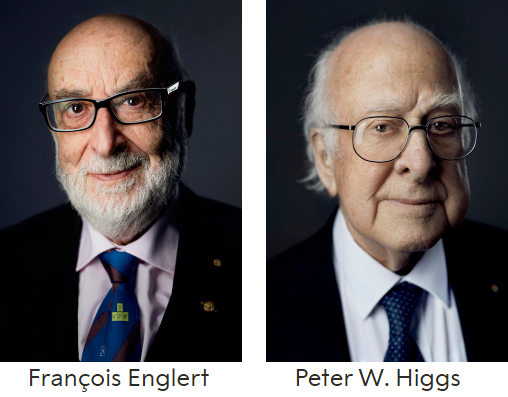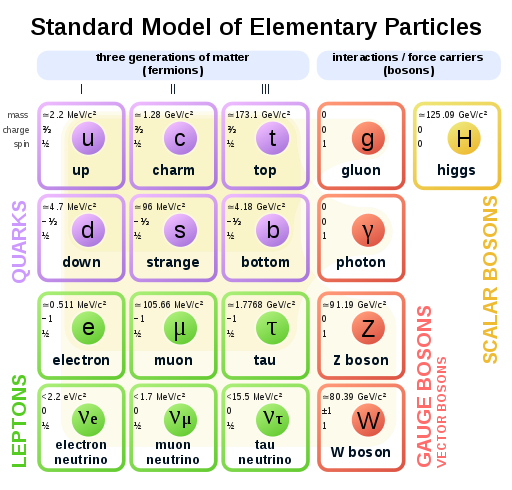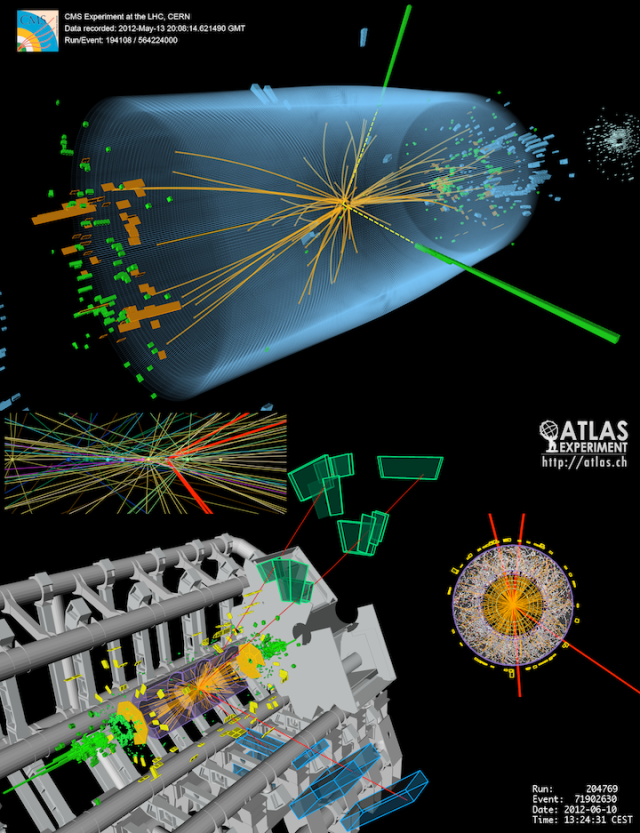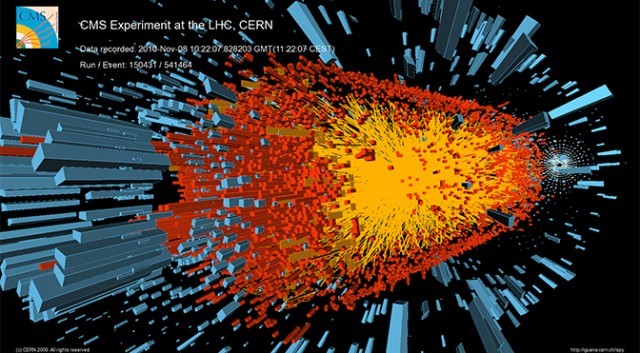The Higgs boson
The Higgs boson is an elementary particle in the Standard Model of particle physics, produced by the quantum excitation of the Higgs field, one of the fields in particle physics theory. It is named after physicist Peter Higgs, who in 1964, along with six other scientists, proposed the mechanism, which suggested the existence of such a particle. Its existence was confirmed by the ATLAS and CMS collaborations based on collisions in the LHC at CERN.
On December 10, 2013, two of the physicists, Peter Higgs and François Englert, were awarded the Nobel Prize in Physics for their theoretical predictions. Although Higgs's name has come to be associated with this theory, several researchers between about 1964 and 1972 independently developed different parts of it.

In mainstream media the Higgs boson has often been called the "God particle", from a 1993 book on the topic, although the nickname is strongly disliked by many physicists, including Higgs himself, who regard it as sensationalistic.
The Standard Model
Physicists explain the properties and forces between elementary particles in terms of the Standard Model – a widely accepted framework for understanding almost everything in the known universe, other than gravity. (A separate theory, General Relativity, is used for gravity.) In this model, the fundamental forces in nature arise from properties of our universe called gauge invariance and symmetries. The forces are transmitted by particles known as gauge bosons.

In the Standard Model, the Higgs particle is a boson with spin zero, no electric charge and no colour charge. It is also very unstable, decaying into other particles almost immediately. The Higgs field is a scalar field, with two neutral and two electrically charged components that form a complex doublet of the weak isospin SU(2) symmetry. The Higgs field has a "Mexican hat-shaped" potential. In its ground state, this causes the field to have a nonzero value everywhere (including otherwise empty space), and as a result, below a very high energy it breaks the weak isospin symmetry of the electroweak interaction. (Technically the non-zero expectation value converts the Lagrangian's Yukawa coupling terms into mass terms). When this happens, three components of the Higgs field are "absorbed" by the SU(2) and U(1) gauge bosons (the "Higgs mechanism") to become the longitudinal components of the now-massive W and Z bosons of the weak force. The remaining electrically neutral component either manifests as a Higgs particle, or may couple separately to other particles known as fermions (via Yukawa couplings), causing these to acquire mass as well.
Higgs mechanism
Following the 1962 and 1963 papers, three groups of researchers independently published the 1964 PRL symmetry breaking papers with similar conclusions: that the conditions for electroweak symmetry would be "broken" if an unusual type of field existed throughout the universe, and indeed, some fundamental particles would acquire mass. The field required for this to happen (which was purely hypothetical at the time) became known as the Higgs field (after Peter Higgs, one of the researchers) and the mechanism by which it led to symmetry breaking, known as the Higgs mechanism. A key feature of the necessary field is that it would take less energy for the field to have a non-zero value than a zero value, unlike all other known fields, therefore, the Higgs field has a non-zero value (or vacuum expectation) everywhere. It was the first proposal capable of showing how the weak force gauge bosons could have mass despite their governing symmetry, within a gauge invariant theory.
Although these ideas did not gain much initial support or attention, by 1972 they had been developed into a comprehensive theory and proved capable of giving "sensible" results that accurately described particles known at the time, and which, with exceptional accuracy, predicted several other particles discovered during the following years. During the 1970s these theories rapidly became the Standard Model of particle physics. There was not yet any direct evidence that the Higgs field existed, but even without proof of the field, the accuracy of its predictions led scientists to believe the theory might be true. By the 1980s the question of whether or not the Higgs field existed, and therefore whether or not the entire Standard Model was correct, had come to be regarded as one of the most important unanswered questions in particle physics.
Higgs field
According to the Standard Model, a field of the necessary kind (the Higgs field) exists throughout space and breaks certain symmetry laws of the electroweak interaction. Via the Higgs mechanism, this field causes the gauge bosons of the weak force to be massive at all temperatures below an extreme high value. When the weak force bosons acquire mass, this affects their range, which becomes very small. Furthermore, it was later realised that the same field would also explain, in a different way, why other fundamental constituents of matter (including electrons and quarks) have mass.
For many decades, scientists had no way to determine whether or not the Higgs field existed, because the technology needed for its detection did not exist at that time. If the Higgs field did exist, then it would be unlike any other known fundamental field, but it also was possible that these key ideas, or even the entire Standard Model, were somehow incorrect. Only discovering that the Higgs boson and therefore the Higgs field existed solved the problem.
Unlike other known fields such as the electromagnetic field, the Higgs field is scalar and has a non-zero constant value in vacuum. The existence of the Higgs field became the last unverified part of the Standard Model of particle physics, and for several decades, was considered "the central problem in particle physics".
The presence of the field, now confirmed by experimental investigation, explains why some fundamental particles have mass, despite the symmetries controlling their interactions implying that they should be massless. It also resolves several other long-standing puzzles, such as the reason for the extremely short range of the weak force.
Although the Higgs field is non-zero everywhere and its effects are ubiquitous, proving its existence was far from easy. In principle, it can be proved to exist by detecting its excitations, which manifest as Higgs particles (the Higgs boson), but these are extremely difficult to produce and detect. The importance of this fundamental question led to a 40-year search, and the construction of one of the world's most expensive and complex experimental facilities to date, CERN's Large Hadron Collider, in an attempt to create Higgs bosons and other particles for observation and study. On 4 July 2012, the discovery of a new particle with a mass between 125 and 127 GeV/c2 was announced; physicists suspected that it was the Higgs boson. Since then, the particle has been shown to behave, interact, and decay in many of the ways predicted for Higgs particles by the Standard Model, as well as having even parity and zero spin, two fundamental attributes of a Higgs boson. This also means it is the first elementary scalar particle discovered in nature. As of 2018, in-depth research shows the particle continuing to behave in line with predictions for the Standard Model Higgs boson. More studies are needed to verify with higher precision that the discovered particle has all of the properties predicted, or whether, as described by some theories, multiple Higgs bosons exist.
Higgs boson
The hypothesised Higgs mechanism made several accurate predictions, however to confirm its existence there was an extensive search for a matching particle associated with it — the "Higgs boson". Detecting Higgs bosons was difficult due to the energy required to produce them and their very rare production even if the energy is sufficient. It was therefore several decades before the first evidence of the Higgs boson was found. Particle colliders, detectors, and computers capable of looking for Higgs bosons took more than 30 years (c. 1980–2010) to develop.
By March 2013, the existence of the Higgs boson was confirmed, and therefore, the concept of some type of Higgs field throughout space is strongly supported. The nature and properties of this field are now being investigated further, using more data collected at the LHC.
Interpretation
Various analogies have been used to describe the Higgs field and boson, including analogies with well-known symmetry-breaking effects such as the rainbow and prism, electric fields, ripples, and resistance of macro objects moving through media (such as people moving through crowds or some objects moving through syrup or molasses). However, analogies based on simple resistance to motion are inaccurate, as the Higgs field does not work by resisting motion.
Experimental search
To produce Higgs bosons, two beams of particles are accelerated to very high energies and allowed to collide within a particle detector. Occasionally, although rarely, a Higgs boson will be created fleetingly as part of the collision byproducts. Because the Higgs boson decays very quickly, particle detectors cannot detect it directly. Instead the detectors register all the decay products (the decay signature) and from the data the decay process is reconstructed. If the observed decay products match a possible decay process (known as a decay channel) of a Higgs boson, this indicates that a Higgs boson may have been created. In practice, many processes may produce similar decay signatures. Fortunately, the Standard Model precisely predicts the likelihood of each of these, and each known process, occurring. So, if the detector detects more decay signatures consistently matching a Higgs boson than would otherwise be expected if Higgs bosons did not exist, then this would be strong evidence that the Higgs boson exists.
Because Higgs boson production in a particle collision is likely to be very rare (1 in 10 billion at the LHC), and many other possible collision events can have similar decay signatures, the data of hundreds of trillions of collisions needs to be analysed and must "show the same picture" before a conclusion about the existence of the Higgs boson can be reached. To conclude that a new particle has been found, particle physicists require that the statistical analysis of two independent particle detectors each indicate that there is lesser than a one-in-a-million chance that the observed decay signatures are due to just background random Standard Model events—i.e., that the observed number of events is more than 5 standard deviations (sigma) different from that expected if there was no new particle. More collision data allows better confirmation of the physical properties of any new particle observed, and allows physicists to decide whether it is indeed a Higgs boson as described by the Standard Model or some other hypothetical new particle.
To find the Higgs boson, a powerful particle accelerator was needed, because Higgs bosons might not be seen in lower-energy experiments. The collider needed to have a high luminosity in order to ensure enough collisions were seen for conclusions to be drawn. Finally, advanced computing facilities were needed to process the vast amount of data (25 petabytes per year as of 2012) produced by the collisions. For the announcement of 4 July 2012, a new collider known as the Large Hadron Collider was constructed at CERN with a planned eventual collision energy of 14 TeV—over seven times any previous collider—and over 300 trillion (3×1014) LHC proton–proton collisions were analysed by the LHC Computing Grid, the world's largest computing grid (as of 2012), comprising over 170 computing facilities in a worldwide network across 36 countries.
Discovery of candidate boson at CERN
On 22 June 2012 CERN announced an upcoming seminar covering tentative findings for 2012, and shortly afterwards (from around 1 July 2012 according to an analysis of the spreading rumour in social media) rumours began to spread in the media that this would include a major announcement, but it was unclear whether this would be a stronger signal or a formal discovery. Speculation escalated to a "fevered" pitch when reports emerged that Peter Higgs, who proposed the particle, was to be attending the seminar, and that "five leading physicists" had been invited – generally believed to signify the five living 1964 authors – with Higgs, Englert, Guralnik, Hagen attending and Kibble confirming his invitation (Brout having died in 2011).

Left: Diphoton channel: Boson subsequently decays into 2 gamma ray photons by virtual interaction with a W boson loop or top quark loop. Right: 4-Lepton "golden channel": Boson emits 2 Z bosons, which each decay into 2 leptons (electrons, muons).
Experimental analysis of these channels reached a significance of more than 5 sigma in both experiments.
On 4 July 2012 both of the CERN experiments announced they had independently made the same discovery: CMS of a previously unknown boson with mass 125.3 ± 0.6 GeV/c2 and ATLAS of a boson with mass 126.0 ± 0.6 GeV/c2. Using the combined analysis of two interaction types (known as 'channels'), both experiments independently reached a local significance of 5 sigma — implying that the probability of getting at least as strong a result by chance alone is less than 1 in 3 million. When additional channels were taken into account, the CMS significance was reduced to 4.9 sigma.
The two teams had been working 'blinded' from each other from around late 2011 or early 2012, meaning they did not discuss their results with each other, providing additional certainty that any common finding was genuine validation of a particle. This level of evidence, confirmed independently by two separate teams and experiments, meets the formal level of proof required to announce a confirmed discovery.
On 31 July 2012, the ATLAS collaboration presented additional data analysis on the "observation of a new particle", including data from a third channel, which improved the significance to 5.9 sigma (1 in 588 million chance of obtaining at least as strong evidence by random background effects alone) and mass 126.0 ± 0.4 (stat) ± 0.4 (sys) GeV/c2, and CMS improved the significance to 5-sigma and mass 125.3 ± 0.4 (stat) ± 0.5 (sys) GeV/c2.
The new particle tested as a possible Higgs boson
Following the 2012 discovery, it was still unconfirmed whether or not the 125 GeV/c2 particle was a Higgs boson. On one hand, observations remained consistent with the observed particle being the Standard Model Higgs boson, and the particle decayed into at least some of the predicted channels. Moreover, the production rates and branching ratios for the observed channels broadly matched the predictions by the Standard Model within the experimental uncertainties. However, the experimental uncertainties currently still left room for alternative explanations, meaning an announcement of the discovery of a Higgs boson would have been premature. To allow more opportunity for data collection, the LHC's proposed 2012 shutdown and 2013–14 upgrade were postponed by 7 weeks into 2013.
In November 2012, in a conference in Kyoto researchers said evidence gathered since July was falling into line with the basic Standard Model more than its alternatives, with a range of results for several interactions matching that theory's predictions. Physicist Matt Strassler highlighted "considerable" evidence that the new particle is not a pseudoscalar negative parity particle (consistent with this required finding for a Higgs boson), "evaporation" or lack of increased significance for previous hints of non-Standard Model findings, expected Standard Model interactions with W and Z bosons, absence of "significant new implications" for or against supersymmetry, and in general no significant deviations to date from the results expected of a Standard Model Higgs boson. However some kinds of extensions to the Standard Model would also show very similar results;so commentators noted that based on other particles that are still being understood long after their discovery, it may take years to be sure, and decades to fully understand the particle that has been found.
These findings meant that as of January 2013, scientists were very sure they had found an unknown particle of mass ~ 125 GeV/c2, and had not been misled by experimental error or a chance result. They were also sure, from initial observations, that the new particle was some kind of boson. The behaviours and properties of the particle, so far as examined since July 2012, also seemed quite close to the behaviours expected of a Higgs boson. Even so, it could still have been a Higgs boson or some other unknown boson, since future tests could show behaviours that do not match a Higgs boson, so as of December 2012 CERN still only stated that the new particle was "consistent with" the Higgs boson, and scientists did not yet positively say it was the Higgs boson. Despite this, in late 2012, widespread media reports announced (incorrectly) that a Higgs boson had been confirmed during the year.
In January 2013, CERN director-general Rolf-Dieter Heuer stated that based on data analysis to date, an answer could be possible 'towards' mid-2013, and the deputy chair of physics at Brookhaven National Laboratory stated in February 2013 that a "definitive" answer might require "another few years" after the collider's 2015 restart. In early March 2013, CERN Research Director Sergio Bertolucci stated that confirming spin-0 was the major remaining requirement to determine whether the particle is at least some kind of Higgs boson.
Confirmation of existence and current status
On 14 March 2013 CERN confirmed that:
"CMS and ATLAS have compared a number of options for the spin-parity of this particle, and these all prefer no spin and even parity [two fundamental criteria of a Higgs boson consistent with the Standard Model]. This, coupled with the measured interactions of the new particle with other particles, strongly indicates that it is a Higgs boson."
This also makes the particle the first elementary scalar particle to be discovered in nature.
Examples of tests used to validate that the discovered particle is the Higgs boson:

Significance
Evidence of the Higgs field and its properties has been extremely significant for many reasons. The importance of the Higgs boson is largely that it is able to be examined using existing knowledge and experimental technology, as a way to confirm and study the entire Higgs field theory. Conversely, proof that the Higgs field and boson do not exist would have also been significant.
Validation of the Standard Model
The Higgs boson validates the Standard Model through the mechanism of mass generation. As more precise measurements of its properties are made, more advanced extensions may be suggested or excluded. As experimental means to measure the field's behaviours and interactions are developed, this fundamental field may be better understood. If the Higgs field had not been discovered, the Standard Model would have needed to be modified or superseded.
Related to this, a belief generally exists among physicists that there is likely to be "new" physics beyond the Standard Model, and the Standard Model will at some point be extended or superseded. The Higgs discovery, as well as the many measured collisions occurring at the LHC, provide physicists a sensitive tool to parse data for where the Standard Model fails, and could provide considerable evidence guiding researchers into future theoretical developments.
Symmetry breaking of the electroweak interaction
Below an extremely high temperature, electroweak symmetry breaking causes the electroweak interaction to manifest in part as the short-ranged weak force, which is carried by massive gauge bosons. This symmetry breaking is required for atoms and other structures to form, as well as for nuclear reactions in stars, such as our Sun. The Higgs field is responsible for this symmetry breaking.
Particle mass acquisition
The Higgs field is pivotal in generating the masses of quarks and charged leptons (through Yukawa coupling) and the W and Z gauge bosons (through the Higgs mechanism).
It is worth noting that the Higgs field does not "create" mass out of nothing (which would violate the law of conservation of energy), nor is the Higgs field responsible for the mass of all particles. For example, approximately 99% of the mass of baryons (composite particles such as the proton and neutron), is due instead to quantum chromodynamics binding energy, which is the sum of the kinetic energies of quarks and the energies of the massless gluons mediating the strong interaction inside the baryons. In Higgs-based theories, the property of "mass" is a manifestation of potential energy transferred to fundamental particles when they interact ("couple") with the Higgs field, which had contained that mass in the form of energy.
Scalar fields and extension of the Standard Model
The Higgs field is the only scalar (spin 0) field to be detected; all the other fields in the Standard Model are spin ½ fermions or spin 1 bosons. According to Rolf-Dieter Heuer, director general of CERN when the Higgs boson was discovered, this existence proof of a scalar field is almost as important the Higgs's role in determining the mass of other particles. It suggests that other hypothetical scalar fields suggested by other theories, from the inflaton to quintessence, could perhaps exist as well.

A problem for many years has been that no experiment has observed the Higgs boson to confirm the theory. On 4 July 2012, the ATLAS and CMS experiments at CERN's Large Hadron Collider announced they had each observed a new particle in the mass region around 125 GeV. This particle is consistent with the Higgs boson but it will take further work to determine whether or not it is the Higgs boson predicted by the Standard Model. The Higgs boson, as proposed within the Standard Model, is the simplest manifestation of the Brout-Englert-Higgs mechanism. Other types of Higgs bosons are predicted by other theories that go beyond the Standard Model.On 8 October 2013 the Nobel prize in physics was awarded jointly to François Englert and Peter Higgs “for the theoretical discovery of a mechanism that contributes to our understanding of the origin of mass of subatomic particles, and which recently was confirmed through the discovery of the predicted fundamental particle, by the ATLAS and CMS experiments at CERN's Large Hadron Collider”.







REFERENCES
CERN. Available in: https://home.cern/science/physics/higgs-boson. Access in: 18/11/2018.
Nobel Prize. Available in: https://www.nobelprize.org/prizes/physics/2013/press-release/. Access in: 18/11/2018.
Wikipedia. Available in: https://en.wikipedia.org/wiki/Higgs_boson. Access in: 18/11/2018.














0 comments
Sign in or create a free account